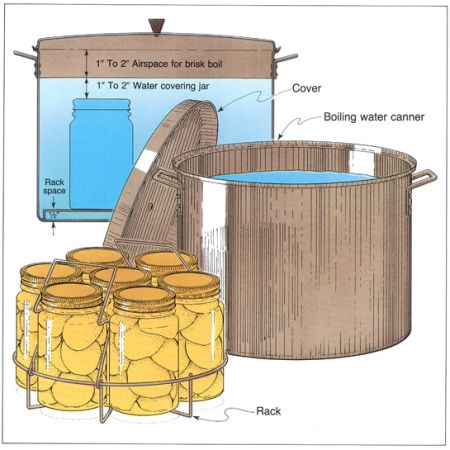Water Bath Canning and Pressure Canning Basics for Safe Food Storage

To clear up some confusion about water bath canning versus pressure canning we just want to go over some basics. This is especially important because you are preserving food that you hope will increase your chances of survival in some kind of life-changing event. Therefore you want to make sure what you are preserving will be just as healthy and safe the day you eat it as it was the day you canned it.
What is Water Bath Canning?
Also known as “boiling water canning” this method performs by boiling the jars of food for a specified amount of time. Here are a few basic guidelines:
- The jars must be completely submerged, with a minimum of one inch of water above the top of the jars.
- Always use the rack insert to hold the jars.
- Only process high-acid foods like: fruit (including tomatoes), preserves (jams & jellies), anything pickled.
- NEVER process vegetables or meat by water bath canning; they are low acid.
- It is possible to use your pressure canner as a boiling water canner; simply leave the lid off.
What is Pressure Canning?
As the name implies pressure, as in steam pressure, is used to process the jars of food, using a pot with a lid that fastens securely allowing pressure to build up as that water inside heats. Here are a few basic guidelines:
- The jars do NOT have to be completely submerged, but make sure the water comes up to about halfway on the jars.
- Make sure the jars are sitting on the flat metal plate in the bottom of the pressure canner.
- ALWAYS process low-acid foods like vegetables or meat in a pressure canner.
- Follow your pressure canner’s instruction book for pressure and processing times, and remember to make adjustments for your altitude.
What is Open Kettle Canning?
Open kettle canning is basically heating up the food to boiling, then placing it in hot jars and immediately putting a lid and ring on. However, instead of then processing the jars in some type of canner, you leave the jars sitting out and allow the heat of the food to “seal” the jars. You’ll get that satisfying ping when the lid seals, BUT…
Without processing either by water bath canning or pressure canning, the temperature doesn’t get hot enough to kill off all bacteria. Therefore you are basically canning up jars of painful death. It is NOT worth it.
Remember the whole reason for preserving food is for survival. Opening a jar of food you canned in this dangerous method is a gamble, and in a future where medical care might not be guaranteed its a sure dance with death.
Other Canning Methods to Avoid
Again only water bath canning and pressure canning produce enough heat to kill the bacteria that cause botulism, so despite what you see on YouTube don’t experiment with other canning methods, such as:
- Oven canning
- Solar canning
- Dishwasher canning
- Microwave canning
- Chemical or powder canning
Also avoid using:
- Mayonnaise jars - only use jars specifically designed for canning
- Wax sealing - only use approved lids and rings designed for your jars
- Jars with wire bales and glass caps
Basic Guidelines for Food Preservation Safety
- Cleanliness is the first step – Wash your hands, the counters and the produce.
- Wipe the jar before placing on the lid – Put some vinegar on a cloth and wipe down the lids to remove any bits of food or grease that would prevent the lid from sealing.
- Make sure your pressure canner is in proper working order. Your county extension office will often offer free testing of your pressure canner. Don’t forget to replace the rubber seal regularly.
- Check the lids BEFORE opening a jar of canned food. If the center is not pressed down tightly, or you can actually press it down, it is NOT sealed. Toss it!
- Do not eat anything that smells bad or is discolored.
While it may appear that danger is everywhere with home canning, whether by water bath canning or pressure canning, by following a few simple guidelines for safety you can be enjoying healthy preserved food well into the future. A lot of it is common sense and trying not to cut corners.
Return from Water Bath Canning to Survival Food Storage





New! Comments
Have your say about what you just read! Leave me a comment in the box below.